Chanoyu and Zen Landscapes Part 2
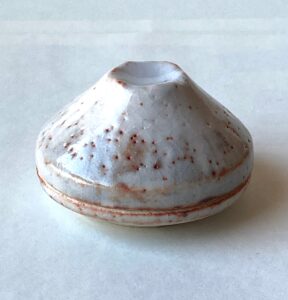
Humans have been attracted to mountains, or at least high places, from their beginnings. The higher the better. Kids play king of the mountain when they are strong enough to wrest it from others. Buildings soar above clouds. Every higher place beckons the climber. The view is never wider. Even in space. What is above or beyond. Japan’s Fujisan has been worshiped from the time of human habitation. It is climbed to see the sunrise, especially on New Year’s morning. Some mountains are too sacred to trespass upon.
The Kanji, hachi, 八, is essentially a triangle, and the triangle with a single point upward is a symbol for fire. The word ‘fuji’ is said to come from the native Ainu language word for ‘fire’. Fuji is dormant fire.
Fuji’s form is, to some, perfect. Gradually rising from the plane to rise above the clouds. Its relatively flat top, slightly concave seems even more evocative. A source of fire and inspiration. Fuji’s profile is like the Japanese number 8, hachi, 八, which is an emblem of Infinity in Space, called sue-hiro, 末広, ends-wide. This fanning outward is found in Japanese iconic folding fan, the sen-su, 扇子, fan-of, which is the necessary emblem of a guest at a Tea gathering.
Unlike the flaring mountain, the sensu is rarely opened in the Tea room. The guest, kyaku, 客, carries the sensu in the right hand while passing through the ro-ji, 露地, dew-ground of the Tearoom. The fan may be emblematic of Rikyū’s roji tsue, 杖, staff, which may itself be identified with Jizō’s shaku-jō, 錫杖, tin-staff, that pilgrims use to frighten away creatures. Attending a Tea gathering is like a pilgrimage of sorts.
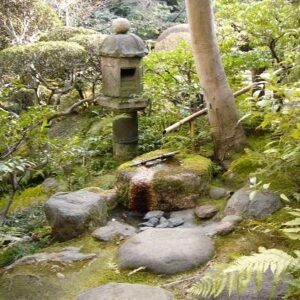
The roji garden has plants, mostly evergreens, few, if any, flowers, moss and ferns, perhaps a pine tree as Rikyū suggested, and a meandering path of tobi-ishi, 飛石, flying-stones. The garden is divided into two parts: the soto ro-ji, 外露地, outer dew-ground, and the uchi ro-ji, 内露地, inner dew-ground. A gate called a chū-mon, 中門, middle-gate, separates the two gardens. It should be remembered that the Kanji, ro, 露, to a Buddhist means ‘enlightenment’. Another chosen aspect of the roji path is a moving stream of water, with a stone as a bridge, hashi, 橋. This is identified with the San-zu no Kawa, 三途の川, Three-crossing’s River, of the Buddhist underworld. Jizō helps departed souls cross the river to enter Buddhist paradise, using his pilgrim’s shakujō to test the depths of the soul’s misdeeds. In the realm of Chanoyu the bamboo pipe is not used to replenish the stone basin.
Perhaps, when the tei-shu, 亭主, house-master, carries a water vessel into the Tearoom is to suggest ‘crossing water’ to enter Buddhist paradise. As there are many stages of paradise, Buddhists of the Pure Land Sect would wish to enter Amida’s western paradise of Goku-raku Jō-do, 極楽浄土, Utter-bliss Pure-land.
The outer roji is an extension of the house or other structure, the material world, and has a bench or separate housing, koshi-kake machi-ai, 腰掛待合, bottom-place wait-gather, where people can sit as though on a chair, and not on their feet. The uchi roji contains the cha-shitsu, 茶室, tea-house, spiritual world, and a purification area called the tsukubai, 蹲踞, crouch-down. The planting in the uchi roji should be simpler and more austere than the outer garden.
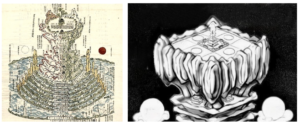
Left: an illustration of Mt. Sumeru, Shu-mi-sen, 須弥山, Necessarily-increase-mountain. Right: an illustration of the upper level with Tō-ri-ten, 忉利天, Grieve-advantage-heaven divided into nine squares, and with mountain peaks at the four corners. Tōriten is the palace garden of Tai-shaku-ten, 帝釈天, Emperor-explain-heaven (Deva), is a great tree, En-shō-ju, 円生樹, Circle-life-tree, that is to the northeast of the palace, and in this location, the tree may be identified with the toko-bashira, 床柱, floor-post. Note that some depictions of Tōriten are in a circular configuration.
Tōriten is the Japanese for the Sanskrit Trayastriṃśa, meaning ‘thirty-three’, which refers the 33 deities who live there. The leader of the 33 gods is Taishakuten, also called Indra- king of the gods, and he lives in the central palace Zen-ken-ten, 善見天, Good-see-heaven. All of this imagined realm is above the clouds.
Japanese gardens have familiar stone arrangements with various identifications, such as the tortoise and the crane. An early feature was introduced by Sui-ko Ten-nō, 推古天皇, Conjecture-old Heaven-emperor, 592-628, who is the 33rd monarch of Japan. Empress Suiko commissioned Michiko, who arrived from from Korea in 612, to make a garden in the southern court in Nara. Its chief feature was a large upright stone from which was identified as Shumisen. This was is part to bring about harmony between the native Japanese belief system and Buddhism being imported from the continent. From this incident, a large upright stone in most Japanese gardens is seen as Mount Sumeru. The native Japanese belief system came to be called Shin-tō, 神道, God-way.
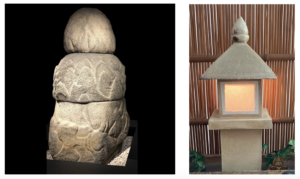
It is believed that the Shumisen Seki was originally four stones, with another stone at the base. The height of the three remaining stones is approximately 6 shaku kujira–jaku. The three stacked stones were excavated in 1902 in the area of Asuka, 飛鳥, Leap-bird. The Shumisen Seki rises out of the earth, which is represented by the Earth part of the stone lantern. The Shumisen Seki was the axis mundi of the imperial garden, just as the stone lantern is the axis mundi of the roji.
In the roji garden, the stone lantern guides people to the tsukubai, where the hands and mouth are purified before entering the Tearoom. The lantern, one of the principle stones in the tsukubai, represents the Shumisen Seki. The stone lantern is composed of five parts that represent the Go-rin, 五輪, Five-rings, principles. Starting from the bottom element Earth, Water in the light basket stone, Fire in the ‘roof’, Wind in the half-moon or bowl, that supports the Void represented by a flaming jewel.
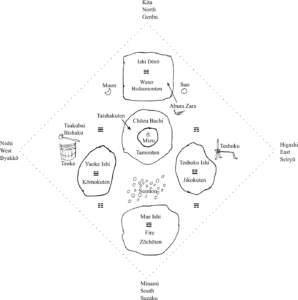
Drawing of the layout of a general tsukubai, 蹲踞, crouch-down. Showing named stones, Buddhist deities, etc. The essential arrangement of the stones is approximately a square turned with the corners forming a diamond. This is the same primary depiction of Tōriten on Mount Shumisen.
There are essential aspects of the tsukubai, including particular stones for specific functions, called yaku-ishi, 役石, purpose-stone. There are five stones that provide such support for rinsing the hands and mouth before entering the Tearoom. The mae-ishi, 前石, fore-stone, where a person crouches for purification. The yu-oke-ishi, 湯桶石, hot water-bucket-stone. The te-shoku-ishi, 手燭石, handle-lamp-stone, to provide light in the dark. The chō-zu-bachi, 手水鉢, hand-water-bowl, which is filled with fresh water from the bucket by the teishu. The teishu purifies the hands and mouth first, and is then followed by the guest. The fifth stone is an ishi-dō-rō, 石灯籠, stone-lamp-basket.
These five stones represent the Go-rin, 五輪, Five-rings, principles: Earth, Water, Fire, Wind, and the Void. They represent Go-shiki, 五色, Five-colors: yellow, white, red, black, and green. The location and height of the stones is specific around a sunken basin. The fore-stone at the front at ground level, the water bucket stone on the left and a little higher, candle lamp stone on the right a little higher as well, the stone basin in the center toward the back and higher still, and stone lantern highest of all, at the back. Often the lantern is misplaced. It is a beacon to the tsukubai, and must be part of the group at the back. Its purpose is to beckon the guest to the area of purification. It does not necessarily illuminate the area.
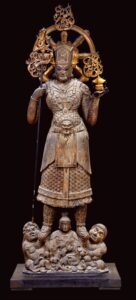
Below the plane of Tōriten is the realm of the Shi-ten-nō, 四天王, Four-heaven-kings, guardians of Buddhism. (The palaces are illustrated in the enlarged illustration of Tōriten above.) Dressed like warriors with fearsome countenances, they govern the four directions. Although they are called Four kings, one of them can take two forms. Bi-sha-mon-ten, 毘沙門天, Help-sand-gate-heaven (Hindi Deva), the leader of the group, is also manifest as Ta-mon-ten, 多聞天, Multi-hear-heaven (Deva).
The character, bi, 毘, of Bishamonten’s name means help, assist, connect, adjoin. Sha-mon, 沙門, sand-gate, refers to ascetic Buddhist monks. The word shamon is thought to be the origin of the word shaman. The character, ten, 天, heaven, in Japanese refers to the Pali and Sanskrit word Deva meaning god.
The character for nō, 王, means king. The Four God-kings in the four directions protect the Buddha and the Dharma, and live on the sides of Mt. Sumeru, Shu-misen, 須弥山, which is both the Buddhist and Hindu center of the world.
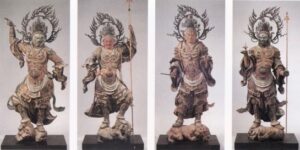
The Shi-ten-nō, 四天王, Four-heaven-kings, are Bi-sha-mon-ten, 毘沙門天, Help-sand-gate-heaven (Hindi Deva) also, as one of the group of four kings, is named Ta-mon-ten, 多聞天, Much-listen-king, and guards the North; Ji-koku-ten, 持国天, Protect-country-king, and guards the East; Zō-chō-ten, 増長天, Increase-long-king, and guards the South; Kō-moku-ten, 広目天, Wide-eye-king, and guards the West. The ideal number of guests for a Tea gathering is four. They sit along the east wall of the Tearoom facing west and the Teishu/ Bishamonten.
Tamonten, who is a prominent aspect of Bishamonten, may be represented by the shō-kyaku, 正客, chief-guest, main and first guest who ideally is seated near the tokonoma, which is metaphorically located in the north, but is located in the northeast corner of the Tearoom. Taishakuten’s great tree of Tōriten may also be identified with the toko-bashira, 床柱, floor-post; the Kanji, hashira, 柱, is used when counting deities.
The Shitennō may be represented by the guests in the Tearoom. The teishu represents, or acts, on behalf of Bishamonten, and the guests represent, or act, on behalf of the Four Kings. Continuing this concept, the shō-kyaku, 正客, main-guest, would represent Tamonten, the counterpart of Bishamonten. The second guest would be Jikokuten, the third guest would be Zōchōten, and the fourth would be Kōmokuten. Kōmokuten as ba-kkyaku, 末客, last-guest, is asked by the host to help give assistance in the Tea presentation, and may enter the preparation room, mizu-ya, 水屋, water-house.
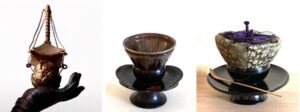
Hō-tō, 宝塔, Treasure-tower, pagoda, on the hand of Bishamonten. Ten-moku cha-wan, 天目茶碗, Heaven-eye tea-bowl, on a dai, 台, support, black-lacquered wood the designs in gold of treasures, made for the Ainu peoples. Tenmoku chawan wrapped in a drawstring silk fabric shi-fuku, 仕覆, serve-cover, on a black-lacquered dai, with bamboo cha-shaku, 茶杓, tea-scoop.
The Daitenmoku chawan representing the Gorin, has the principle of Wind represented by the black tea bowl, is symbolic of In and Yō aspects of aspiration, breathing in and breathing out, which is what happens when we drink tea from the bowl. The Daitenmoku may be likened to Mount Sumeru, the inverted chawan has the stylized profile of a mountain. Ceramics are fabricated Earth.
The spire rising from the roof of the reliquary tower is the ku-rin, 九輪, nine-rings, referring to the nine steps to nirvana. The cord of the chawan shifuku has a permanent braided knot, uchi-dome, 打止, hit-stop, which may evoke the spire, sō-rin, 相輪, mutual-rings. The chashaku may evoke Bishamonten’s san-sa-geki, 三叉戟, three-branch-halberd, trident.
The ‘five’ Kings may be identified with the five stones of the tsukubai.
The stone lantern is the image of the Go-jū-no-tō, 五重塔, Five-tier-tower, of the immortal soul, is held on the upright left hand of Bishamonten, who is thereby identified with the stone lantern. In Buddhism, the Go-jū-no-tō is also called the Hō-tō, 宝塔, Treasure-tower, as it contains the relics of the Buddha. Parallels may also be drawn between the Go-jū-no-tō, 五重塔, Five-tier-tower, and the highly esteemed five-part Chinese Dai Ten-moku cha-wan, 台天目茶碗, Support Heaven-eye tea-bowl.
Bishamonten’s other self, Ta-mon-ten, 多聞天, Multi-hear-heaven (Deva), also carries the Hōtō reliquary on his right hand, and is identified with the north, Gen-bu, 玄武, Black-warrior and the turtle/snake. Tamonten may be associated with Kan-non Bo-satsu, 観音菩薩, See-sound Grass-buddha, who is also identified with the north, and whose name means ‘sound’. Tamonten’s skin color is black. He lives on the north side of Shu-mi-sen, 須弥山, which is made of gold, and lives in the Ten-kei-jō, 天敬城, Heaven-respect-castle.
The bowl of the chōzu-bachi is the realm of Tamonten, and a manifestation of the Buddha’s taku-hatsu, 托鉢, request-bowl. Each of the four Kings, gave a bowl to the Buddha, which the Buddha transformed into a single black bowl made of lapis lazuli.
The teshoku ishi is the realm of Ji-koku-ten, 持国天, Hold-country-heaven (Deva), is guardian of the east, is green, spring.
The mae ishi is the realm of Zō-chō-ten, 増長天, Increase-long-heaven (Deva), Virudhaka (Skrt.), guardian of the south, and rules over earth creatures, Ja-ki, 邪鬼, Wicked-demon, some with horse heads. Zōchōten’s skin color is red, the color of fire, summer, and the south direction.
The yuoke ishi is the realm of Kō-moku-ten, 広目天, Wide-eye-heaven (Deva), has white skin, has limitless vision, autumn, guardian of the west.
The Shumisen mountain is described as having four sides made of precious materials facing in the cardinal directions — gold facing north, crystal to the east, lapis lazuli south, and ruby west. From those four faces issue four great rivers that flow out into the various seas and mountain ranges that surround the towering Mount Meru.

For further study, see also: Chanoyu and Zen Landscapes, Anatomy of Japanese Tea Ceremony Lecture 6: The Roji, and Sekimori Ishi and Ganesha

